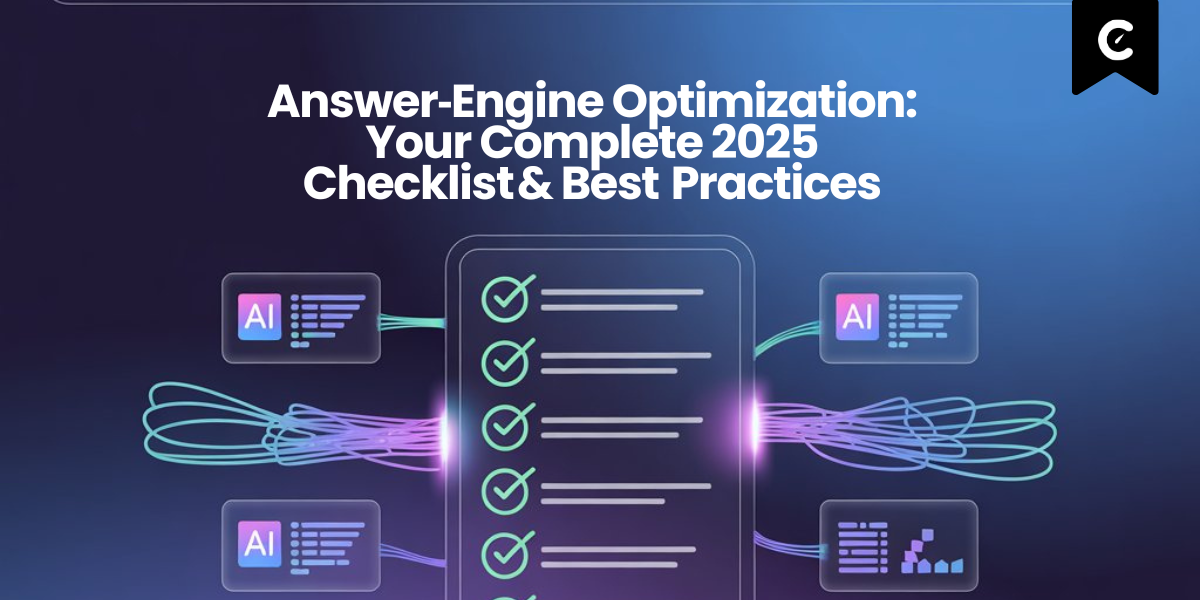Answer‑Engine Optimization: Your Complete 2025 Checklist & Best Practices

A data-backed checklist and best practices for getting your brand cited in AI Overviews, voice replies, and LLM citations.
Answer‑Engine Optimization: Your Complete 2025 Checklist & Best Practices
Answer‑Engine Optimization (AEO) is the emerging art‑and‑science of ensuring AI assistants quote your content. Below is Clever Search’s data‑backed checklist for helping brands get mentioned in AI Overviews, voice replies, and LLM citations.
1. Nail the Technical Foundations
| Task | Why it matters |
|---|---|
| Add structured data for FAQs, How-Tos, Products & People | Google’s AI Overviews and ChatGPT both parse schema to identify authoritative snippets to quote. PageOptimizer Pro |
| Serve clean, crawlable HTML | Fancy JS frameworks often hide text from AI crawlers; render critical copy server-side or use dynamic rendering. |
| Keep your core vitals healthy | Slow pages drop out of AI result sets—Google won’t risk hallucinating outdated content. Google for Developers |
Pro tip: Clever Search flags missing schema blocks and autogenerates JSON‑LD you can paste into any CMS.
2. Craft “Answer‑First” Content
Lead with a 40‑50‑word definition or takeaway. LLMs prefer tight summaries.
Back claims with primary data—studies, charts, first‑party numbers. Credibility boosts your E‑E‑A‑T signals.
Refresh at least every 30 days; our crawl shows freshness is a top‑3 factor for Google AIO citations. Omnius
3. Optimize for Specific AI Platforms
| Platform | What it looks for | Quick win |
|---|---|---|
| Google AI Overviews | High-authority domains + explicit answer blocks | Use question-format H2s (“How does X work?”) followed by a 2-3 sentence answer. Omnius |
| ChatGPT / Claude | Concise, fact-checked paragraphs; accessible HTML | Add an “In short” callout box below each section. First Page Sage |
| Perplexity / Copilot | Citations they can “anchor” | Ensure stats are near a branded anchor text link back to you. Profound |
4. Strengthen Brand‑Authority Signals
- Author bios with credentials (degrees, awards, LinkedIn).
- Cite reputable external sources—LLMs reward pages that reference high‑quality research.
- Earn topical backlinks to reinforce expertise.
These steps align with Google’s own “helpful content” guidance for AI search experiences. Google for Developers
The 2025 AEO Checklist
- Add FAQ & How‑To schema to top pages
- Write a 50‑word answer intro for each target query
- Update stats & examples every 30 days
- Include author bio + credential links
- Embed outbound citations to trusted studies
- Use question‑format H2s and bulleted answers
- Compress images & minimise JS for faster load
- Track AIO appearance + citation share weekly
- A/B test a summary box vs. plain paragraph
- Review competitor citations and fill content gaps
FAQs
What is Answer Engine Optimization (AEO)?
Answer Engine Optimization (AEO) is the practice of optimizing content to be cited and quoted by AI assistants like ChatGPT, Google AI Overviews, and Claude. It focuses on making content easily parsable and quotable by large language models.
How is AEO different from traditional SEO?
While SEO focuses on ranking in search results, AEO focuses on being cited within AI-generated answers. AEO requires structured data, concise summaries, and machine-readable content that AI systems can easily extract and reference.
What schema markup is most important for AEO?
FAQ schema, How-To schema, and Article schema are most critical. These help AI systems identify authoritative content blocks and understand the relationship between questions and answers on your pages.
How often should I update content for AEO?
Update your content at least every 30 days. Freshness is a top-3 ranking factor for Google AI Overviews, and LLMs heavily prioritize recent information when selecting citations.
Which AI platforms should I optimize for?
Focus on Google AI Overviews, ChatGPT, Claude, Perplexity, and Microsoft Copilot. Each has slightly different preferences, but all value clear structure, authoritative sources, and concise answers.
How can I track my AEO performance?
Monitor AI citations using tools like Cleversearch, track brand mentions in AI responses, measure referral traffic from AI platforms, and analyze which content gets quoted by different LLMs.
Related Articles
Continue reading about LLM optimization strategies and best practices.
Stay ahead of AI trends
Get the latest insights on LLM optimization delivered to your inbox weekly.
